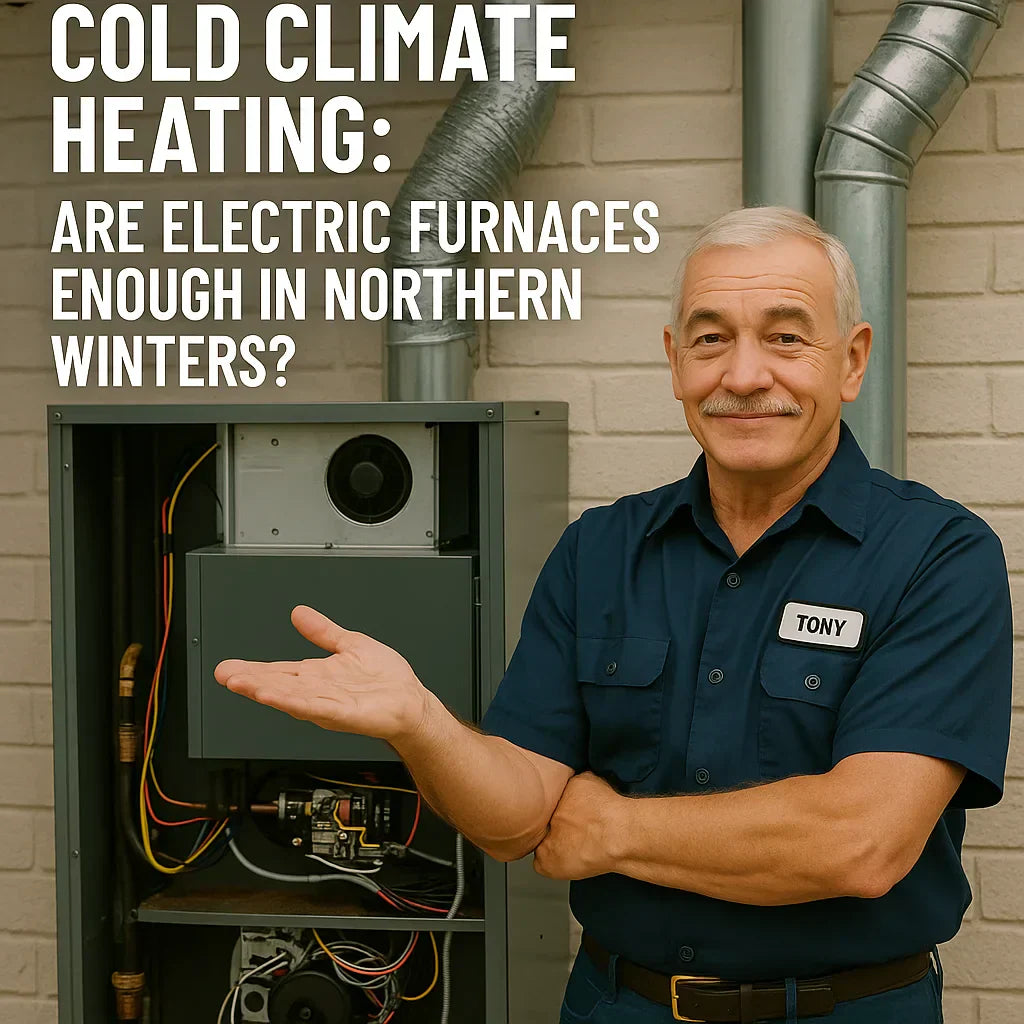🏡 Introduction: The Northern Heating Challenge
If you live in a cold climate, heating isn’t just about comfort—it’s about survival. Sub-zero temperatures demand powerful, reliable heat sources. Can electric furnaces stand up to harsh northern winters? In this comprehensive guide, Tony Marino explores the real-world performance, costs, and tradeoffs of electric furnaces in cold climates.
🔄 How Cold Affects Heating Load Requirements
-
The colder your climate, the higher your home's heating load.
-
Homes in Zone 6-7 (Northern Plains, Great Lakes, New England, Canada) often require 50-60 BTUs per square foot.
-
Large homes with poor insulation may need 100,000+ BTUs on peak winter days.
ASHRAE - Climate Zone Map and Data
🌬️ Electric Furnace Heating Capacity in Cold Climates
| Furnace Size | BTU Output | Max Sq Ft (Cold Climate) |
|---|---|---|
| 10 kW | 34,120 BTUs | ~700-800 sq ft |
| 15 kW | 51,180 BTUs | ~900-1,300 sq ft |
| 20 kW | 68,240 BTUs | ~1,400-1,800 sq ft |
-
Homes larger than 2,000 sq ft may need multiple systems or supplemental heat.
-
Proper insulation and air sealing dramatically reduce load.
Energy.gov - Heating System Sizing
💸 Electric Furnace Operating Cost at Cold Temperatures
-
Peak winter electricity consumption can get very high.
-
Operating cost depends heavily on local electric rates.
| Scenario | Furnace Size | Daily Cost (8 hours/day, 0°F) |
| Midwest | 15 kW | ~$18/day (at $0.15/kWh) |
| Northeast | 20 kW | ~$32/day (at $0.20/kWh) |
| Alaska | 20 kW | ~$38/day (at $0.24/kWh) |
U.S. Energy Information Administration - 2025 Rates
🔓 Why Electric Furnaces Struggle in Extreme Cold
-
Electric furnaces work constantly during long cold snaps.
-
Extended high loads strain electrical panels.
-
Blackouts during storms leave no heat backup.
-
Grid demand spikes in extreme cold can drive rolling outages.
NREL - Grid Resilience in Cold Weather
🏦 When Electric Furnaces Work Well in Cold Climates
-
New construction with top-tier insulation (R-40+)
-
Smaller, airtight, high-efficiency homes
-
Paired with whole-home battery backup or solar microgrids
-
Rural areas without natural gas pipelines
-
Zoned systems controlling only occupied rooms
💩 Risks of All-Electric Heating in Northern Winters
-
Grid Dependency: Total reliance on electrical grid stability.
-
Power Outages: Severe storms can leave homes without heat.
-
Electric Rate Volatility: Cold snaps often drive price surges in deregulated markets.
-
Panel Load: Some older homes lack sufficient panel capacity for high-kW furnaces.
-
Backup Heating Required: Space heaters or generators often necessary as emergency backups.
🤓 How Heat Pumps Fit Into Cold Climate Electric Heating
-
Modern cold-climate air-source heat pumps operate down to -5°F efficiently.
-
Heat pumps greatly reduce electricity use during mild winter days.
-
Electric furnaces serve as backup (auxiliary heat) when temperatures plummet.
-
Dual-fuel hybrid systems offer additional flexibility.
DOE - Cold Climate Heat Pump Technology
🏦 Generator Backup: A Critical Factor for Northern Electric Furnaces
| Backup Type | Typical Cost |
| Portable Generator (10 kW) | $1,000-$2,000 |
| Whole-Home Standby Generator | $6,000-$12,000 |
| Battery Storage (10-15 kWh) | $8,000-$15,000 |
-
Generators allow furnace operation during outages.
-
Proper sizing is crucial for high-draw electric furnaces.
Consumer Reports - Generator Buying Guide
🤝 Best Practices for Cold Climate Electric Furnace Owners
-
Invest heavily in air sealing, insulation, and weatherization.
-
Use multi-stage or variable-speed furnaces for smoother operation.
-
Consider smart thermostats for zone scheduling.
-
Maintain backup heating sources.
-
Prioritize energy audits before sizing.
-
Upgrade electrical panel well before peak winter loads.
Energy Star - Home Performance Programs
🌐 Where Electric Furnaces Make Sense in Cold Climates (2025 Map)
| Region | Electric Furnace Viability |
| Pacific NW | Excellent (mild winters, cheap hydro power) |
| Northern Rockies | Good with super-insulation |
| Midwest | Moderate (expensive electricity, harsh winters) |
| Northeast | Limited (high electric rates) |
| Canada | Difficult without extreme envelope efficiency |
| Alaska | Not practical for large homes |
🦐 Tony Marino’s Cold Climate Heating Advice
-
"Think whole-home energy package, not just the furnace."
-
"Spend on air sealing before spending on furnace capacity."
-
"Backup power is non-negotiable in deep winter states."
-
"Heat pumps + electric furnaces are ideal combos for northern efficiency."
-
"Stay under 20 kW if possible—higher loads strain many residential panels."
📍 Cold Climate Furnace Solutions from The Furnace Outlet
The Furnace Outlet specializes in cold climate electric heating solutions, including dual-fuel systems, heat pump pairings, and standby power planning. Their expert team can analyze your home’s load requirements, grid capacity, and energy costs to design the safest, most efficient system. Visit The Furnace Outlet Electric Furnaces Collection to schedule a full cold climate consultation.
In the next topic we will read about: Electric vs. Gas Furnaces: Which Makes More Sense for Your Home?







